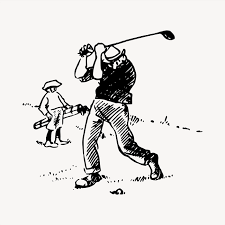
From Thin to Win: Expert Advice on Correcting Thin Shots in Golf
Are your golf shots consistently coming up short? Do you struggle to get the distance and power you desire off the tee or fairway? If so, you're not alone.
Many golfers, from beginners to seasoned players, face the frustrating challenge of thin shots. But fear not, because help is at hand. In this article, we will dive into the world of correcting thin shots in golf and provide you with expert advice to help you transform your game.
From understanding the common causes of thin shots to learning proven techniques and drills, we will guide you on your journey from thin to win. So, whether you're a weekend warrior or an aspiring pro, get ready to elevate your golf game to new heights by mastering the art of striking the ball solidly and consistently.
Let's tee off on this exciting adventure and leave those thin shots behind for good!
Understanding Thin Shots in Golf
To effectively correct thin shots, it's crucial to understand what they are and how they occur. Thin shots are shots where the club strikes the ball too high on its face, resulting in a low trajectory and reduced distance.
These shots can be frustrating, as they often lack the power and accuracy needed to reach your intended target. Understanding the mechanics behind thin shots is the first step towards correcting them and improving your overall game.
There are several common causes of thin shots in golf. One of the main culprits is an improper setup. When your stance, ball position, or posture is incorrect, it can lead to inconsistent ball contact and thin shots.
Additionally, swing mechanics play a significant role. Swinging too steeply, scooping the ball at impact, or failing to maintain a proper swing plane can all contribute to thin shots. Understanding these causes will allow you to address them effectively and make the necessary adjustments to improve your ball striking.
Impact of Thin Shots on Your Golf Game
The impact of thin shots on your golf game goes beyond the frustration of not hitting the ball as you intended. Thin shots can have a significant effect on your scores, confidence, and overall enjoyment of the game.
When you consistently hit thin shots, it becomes challenging to control the distance and accuracy of your shots. This can lead to missed greens, penalty strokes, and a general sense of inconsistency in your game.
Thin shots can also affect your confidence, leading to doubts and hesitations in your swing. By correcting thin shots, you can regain control over your game and experience the joy of striking the ball solidly and consistently.
Correcting Your Setup for Better Ball Contact
One of the key factors in preventing thin shots is establishing a proper setup. Your setup has a direct impact on your ability to make solid contact with the ball. Here are some key elements to consider:
1. Stance: Ensure your feet are shoulder-width apart, providing a stable base for your swing. Distribute your weight evenly between your feet, with a slight bias towards your front foot for more power and control. Avoid leaning back or forward excessively, as this can affect your balance and ball contact.
2. Ball Position: Position the ball slightly ahead of the center of your stance, allowing for a slight downward strike on the ball. This promotes a more solid contact and helps prevent thin shots. Experiment with different ball positions to find the one that works best for you.
3. Posture: Maintain a relaxed, athletic posture throughout your swing. Bend from the hips, not the waist, and keep your back straight. This will enable you to swing on the correct plane and make solid contact with the ball. Avoid slouching or standing too upright, as it can affect your swing mechanics.
By focusing on these elements of your setup, you can improve your ball contact and reduce the likelihood of hitting thin shots. Take the time to practice and fine-tune your setup to find the optimal position that suits your swing and body type.
Adjusting Your Swing Mechanics to Prevent Thin Shots
In addition to a proper setup, your swing mechanics play a crucial role in preventing thin shots. Here are some adjustments you can make to improve your ball striking:br/>
1. Swing Plane: Maintain a consistent swing plane throughout your swing. Avoid swinging too steeply, as it can lead to a glancing blow on the ball and thin shots. Practice swinging on a flatter plane, keeping the clubhead low to the ground in the backswing and downswing.
2. Lag and Release: Focus on creating lag in your downswing by maintaining a slight wrist hinge. This allows you to generate more clubhead speed and power through impact. Release the clubhead at the right moment, ensuring a crisp strike on the ball. By mastering the lag and release, you can avoid scooping the ball and hitting it thin.
3. Weight Transfer: Shift your weight properly during your swing to promote a solid strike. As you initiate your downswing, transfer your weight from your back foot to your front foot. This will help you strike the ball on a descending path and prevent thin shots.
By making these adjustments to your swing mechanics, you can improve your ball striking and reduce the occurrence of thin shots. Practice these changes on the driving range and gradually incorporate them into your on-course play. Consistency and repetition are key to ingraining these adjustments into your muscle memory.br/>
Practice Drills to Improve Ball Striking and Avoid Thin Shots
To reinforce the correct techniques and develop a more consistent ball striking, incorporating practice drills into your training routine is essential. Here are some effective drills to help you improve your ball striking and avoid thin shots:
1. Impact Bag Drill: Use an impact bag or a folded towel placed against a wall as a target. Practice hitting the bag with your clubhead, focusing on making solid contact and avoiding hitting the wall with the hosel or the toe of the club. This drill helps develop a feel for the correct impact position and promotes solid ball striking.
2. Tee Drill: Place a tee in the ground slightly in front of the ball. Swing with the intention of hitting the tee after striking the ball. This drill encourages a downward strike on the ball, preventing thin shots. Start with shorter clubs and gradually progress to longer clubs as you become more comfortable.br/>
3. Divot Drill: Take divots after your shots to ensure a proper ball-turf interaction. Focus on taking divots after the ball, indicating that you are striking the ball first and then the ground. This drill helps prevent thin shots and promotes a more consistent ball flight.
Incorporate these drills into your practice sessions to refine your ball striking and eliminate thin shots from your game. Consistent practice and focus on these drills will translate into improved performance on the course.br/>
Equipment Considerations for Preventing Thin Shots
While technique and practice are crucial for correcting thin shots, the right equipment can also make a difference. Here are some equipment considerations to keep in mind:
1. Club Fitting: Ensure your clubs are properly fitted to your swing and body type. A club fitting session with a professional can help you find the right shaft flex, clubhead design, and club length that suit your swing. Correctly fitted clubs can improve your ball striking and minimize the occurrence of thin shots.
2. Irons and Wedges: Consider using cavity-back irons and wedges with wider soles. These clubs provide more forgiveness on off-center strikes, reducing the likelihood of thin shots. The wider sole helps the club glide more smoothly through the turf, promoting solid contact.
3. Golf Ball Selection: Experiment with different golf ball types to find the one that suits your swing and playing style. Some golf balls offer more forgiveness on mishits, helping to prevent thin shots. Consult with a golf professional or conduct your own testing to find the ball that works best for you.
By paying attention to these equipment considerations, you can optimize your gear to minimize the occurrence of thin shots and enhance your overall performance on the course. Remember, the right equipment is a complement to proper technique and practice.
Expert Tips and Advice for Overcoming Thin Shots
To further assist you in correcting thin shots and improving your game, here are some expert tips and advice:
1. Focus on the Target: Keep your eyes on the target throughout your swing. This helps maintain your focus and prevents any sudden movements that can lead to thin shots.
2. Practice Tempo and Rhythm: Develop a smooth and consistent tempo in your swing. Avoid rushing or decelerating through impact, as it can affect your ball contact. Practice swinging with a metronome or counting in your head to establish a rhythmic swing.
3. Mental Approach: Adopt a positive and confident mindset on the course. Visualize successful shots and trust your swing. Confidence plays a significant role in executing solid ball striking and avoiding thin shots.
By incorporating these expert tips into your game, you can overcome thin shots and elevate your golf performance to new heights. Remember, consistency and practice are key to making these adjustments a natural part of your game.
Common Mistakes to Avoid When Trying to Correct Thin Shots
While it's essential to focus on the correct techniques and advice, it's equally important to be aware of common mistakes that can hinder your progress. Avoid these common pitfalls when trying to correct thin shots:
1. Overcompensation: Don't overcompensate by moving the ball too far back in your stance or trying to scoop the ball to prevent thin shots. These adjustments can lead to other swing issues and negatively impact your overall performance.
2. Neglecting Other Aspects of the Game: While correcting thin shots is crucial, don't neglect other aspects of your game. Work on your short game, course management, and mental approach to achieve a well-rounded golf game.
3. Lack of Patience: Correcting thin shots takes time and practice. Don't expect immediate results. Be patient, trust the process, and focus on incremental improvements.
By avoiding these common mistakes, you can stay on the right track towards correcting thin shots and improving your overall golf game. Consistency and perseverance will lead to long-term success.
Conclusion: Taking Your Game from Thin to Win in Golf
In conclusion, thin shots can be a frustrating challenge for golfers of all skill levels. However, with the right understanding, techniques, and practice, you can overcome this obstacle and transform your game.
By addressing the common causes of thin shots, adjusting your setup and swing mechanics, incorporating practice drills, considering equipment factors, and implementing expert tips, you can elevate your ball striking and consistency.
Remember to avoid common mistakes and approach the process with patience and determination. With time and effort, you can leave those thin shots behind and experience the joy of striking the ball solidly and consistently. So, let's get out on the course, put these strategies into action, and take your game from thin to win in golf!
